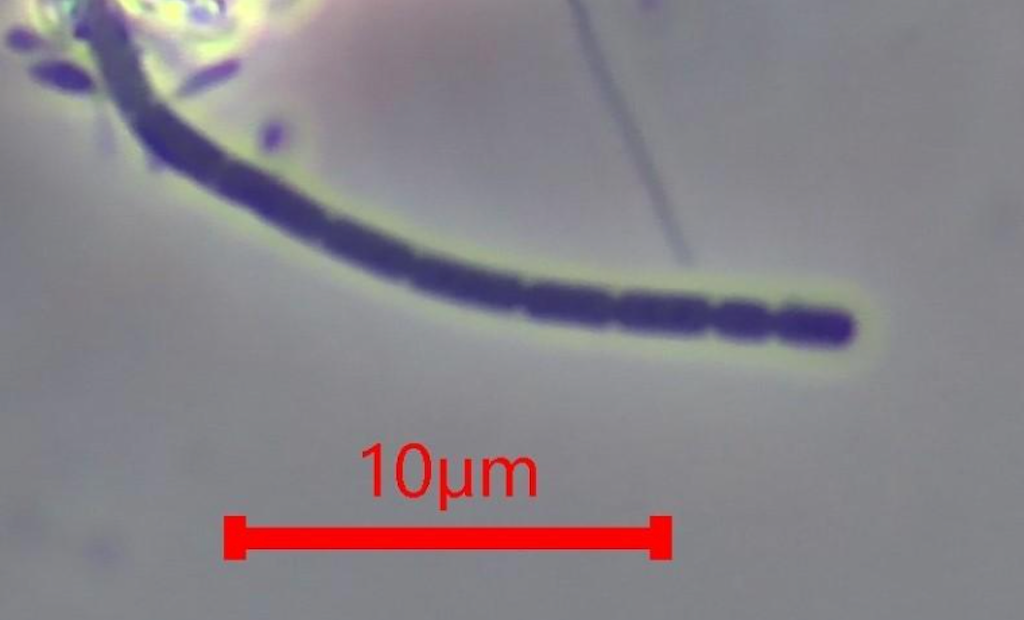Interested in Education/Training?
Get Education/Training articles, news and videos right in your inbox! Sign up now.
Education/Training + Get AlertsType 1701 filaments have highly similar morphology to Sphaerotilus filaments, and these two morphotypes could arguably be combined if the diameter value were broadened. Both filament types are correlated with low dissolved oxygen availability, which will be defined later within this article.
Type 1701 has sausage shaped cells that are generally around 1µm by 1.5µm in dimension, whereas Sphaerotilus morphotypes are larger and generally longer with general cell dimensions of 1.2µm by 2.6µm. While Sphaerotilus morphotypes commonly display “false branching” characteristics, these characteristics are generally less common in the smaller type 1701 morphotypes. Based upon field experience, type 1701 filament types are more likely to have attached growth on the trichome. Both Sphaerotilus and type 1701 morphotypes commonly display PHB granules (fat storage), when growing at high rates.
At the genetic level there is high potential genetic diversity within type 1701 morphotypes including Sphaerotilus (MiDAS recognizes 14 species within the genus), Leptothrix (32 species), Leptothrix sp. FC170 (two species), and likely other Proteobacteria with taxonomic reads at the family level or higher. While not included within the MiDAS field guide, Dr. Paul Cambell of Aster Bio recognizes a specific genus as type 1701, which is currently read individually to the genus level in community sequencing analysis. Curvibacter — a genus that is in the same family as Sphaerotilus, Leptothrix and Aster Bio type 1701 — is also a potential candidate for capability of type 1701 morphology based on general correlations between split samples of microscopy and DNA in our joint work with Aster Bio. From a genetic perspective it is important to note that genera such as Sphaerotilus and Leptothrix have variable filamentous potential, meaning that in addition to growing as filaments, they may also grow in other forms (such as single cell bacteria).
In wastewater processes, type 1701 filaments are recognized as low DO filament types. The term “low DO” is relative to many factors including the available dissolved oxygen concentrations in relation to the oxygen uptake rate of the bacteria. In most municipal systems, DO concentrations of greater than 1-2 mg/L are generally high enough to avoid type 1701 filaments, while in high-rate systems, municipal systems with significant industrial contribution, and industrial wastewater processes, higher DO setpoints (obtaining higher DO residual outside of the flocs) may be required to discourage growth of type 1701 (sometimes 6 mg/L or greater).
If type 1701 filament proliferation is recognized at an early stage, intervention such as increasing the supplied dissolved oxygen concentration and/or slowing down the oxygen uptake rate at the initial contact zone (by lowering the initial F/M ratio) are often successful in preventing a bulking episode. Should type 1701 filaments contribute to sludge bulking, methodologies such as coagulants/settling aids and selective RAS chlorination are often successful. It is common practice to reduce the wasting rate slightly (10-15%) when selective chlorination of the RAS is applied, however, there is no one-size-fits-all approach and every situation should be handled accordingly to the corresponding logistics. Wasting aggressively to control type 1701 is generally not effective as this has the potential to increase the oxygen uptake rate in the initial contact zone of the aeration basin, which may give these filaments a further competitive advantage. As good general practice, it is recommended to always determine the predominant bulking filament types as well as the rest of the big picture when evaluating troubleshooting and operational control changes.
While not recognized as a cause of bulking, genera capable of type 1701 morphology (such as Sphaerotilus and Leptothrix) often have capabilities of oxidizing iron and manganese and are commonly observed in areas such as biofilm growth in drinking water systems.
About the author: Ryan Hennessy is the principal scientist at Ryan Hennessy Wastewater Microbiology. He was trained and mentored by Dr. Michael Richard for over 10 years in wastewater microbiology, and serves as a microbiology services consultant. Hennessy is a licensed wastewater treatment and municipal waterworks operator in the state of Wisconsin and fills in as needed for operations at several facilities. He can be reached at ryan@rhwastewatermicrobiology.com. Hennessy's new book Wastewater Microbiology: Filamentous Bacteria Morphotype Identification Techniques, and Process Control Troubleshooting Strategies is now available on Amazon.






